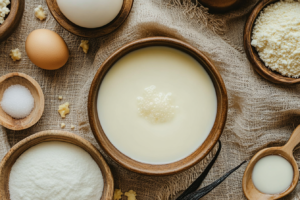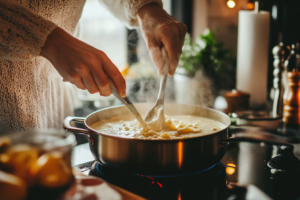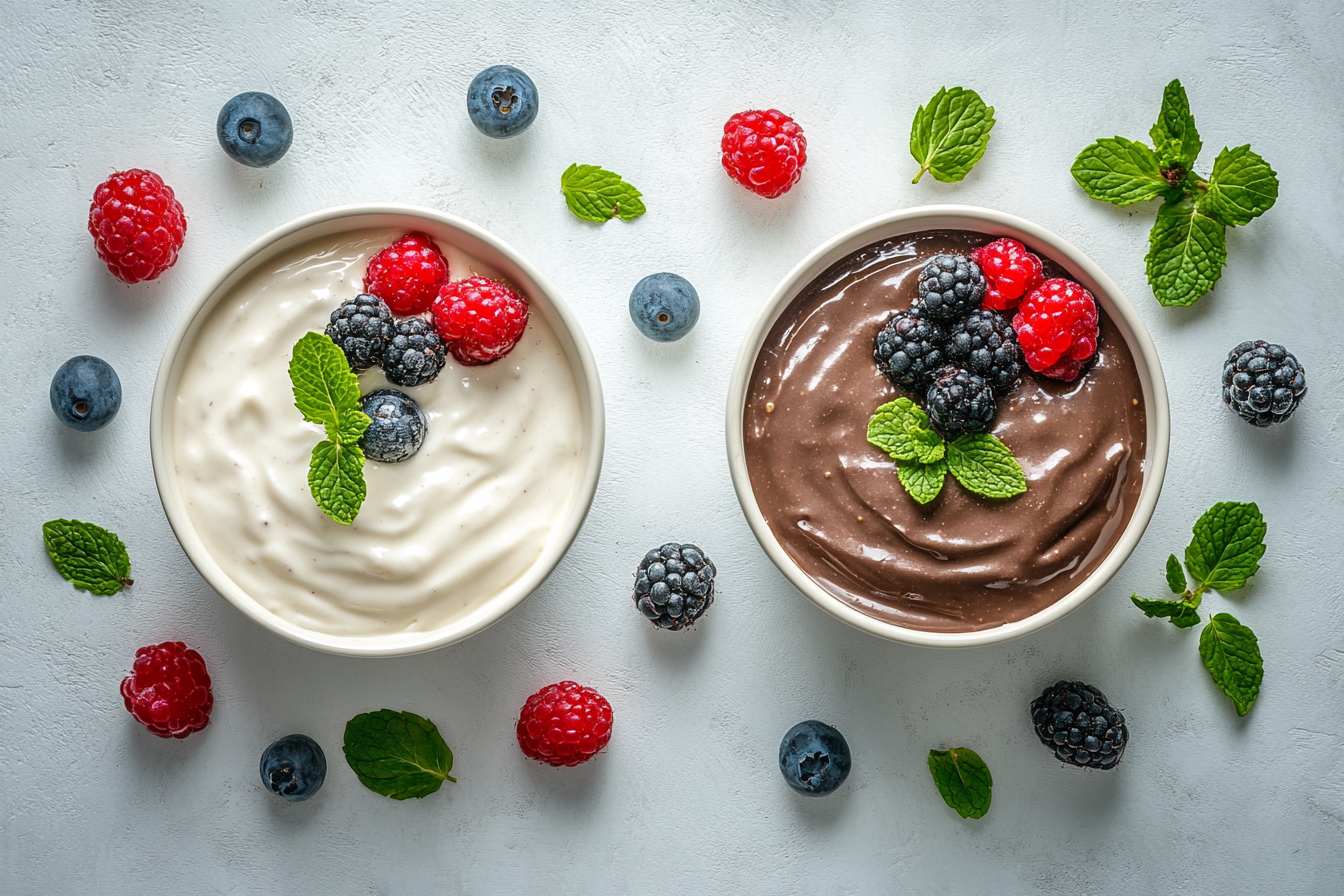Making pudding from scratch sounds tricky, but it’s one of the easiest desserts to whip up with just a few simple ingredients. Whether you’re craving the creamy smoothness of vanilla or the rich taste of chocolate, homemade pudding brings a customizable dessert experience, free from additives. In this guide, you’ll learn step-by-step how to create perfect pudding, troubleshoot common issues, and explore delicious variations. Ready to dive in? Let’s start!
What is Homemade Pudding?
Understanding Homemade Pudding
At its core, homemade pudding combines milk, sugar, and a thickening agent like cornstarch or flour. When you cook these ingredients together, they form a creamy, smooth dessert. Making pudding from scratch creates a fresh taste that boxed mixes can’t match. This method lets you control the flavor and sweetness while avoiding preservatives.
Why Choose Pudding Made from Scratch?
People are turning to homemade pudding recipes because they’re fresh, flavorful, and healthier. Making pudding yourself means you skip artificial colors, flavors, and extra sugar. It’s satisfying to create a dessert that you can adjust to your liking, adding real vanilla, dark chocolate, or even a pinch of cinnamon. This recipe is simple enough to become your go-to dessert when you want something sweet and quick.
Essential Ingredients for Easy Homemade Pudding
Key Ingredients for Making Pudding from Scratch

To make pudding from scratch, you only need a few basic ingredients. Each one is essential for creating that creamy texture and rich flavor that sets homemade pudding apart.
- Milk – Provides the creamy base. Use whole milk for richness, or substitute with almond or oat milk for a dairy-free pudding.
- Sugar – Sweetens the pudding. You can adjust the amount to your taste preference.
- Cornstarch or Flour – Thickens the pudding and gives it a smooth, velvety texture.
- Vanilla or Chocolate Flavoring – Adds depth and character. Use vanilla extract for a classic flavor or cocoa powder for chocolate pudding.
- Butter (Optional) – Adds an extra touch of richness and smoothness to the final pudding.
Tips for Choosing Quality Ingredients in Homemade Pudding Recipes
For the best results in your homemade pudding recipe, go for high-quality ingredients. Fresh milk and pure vanilla extract make a noticeable difference in flavor. Avoid artificial flavors for a more natural taste that will make your pudding shine.
Simple Ingredient Substitutions for Pudding Made from Scratch
If you’re missing any ingredients, here are some easy substitutions to keep your pudding easy and delicious:
- Swap milk with almond, coconut, or oat milk for a dairy-free pudding.
- Substitute sugar with honey or maple syrup if you prefer a natural sweetener.
- Use arrowroot powder or flour if you’re out of cornstarch for thickening.
Step-by-Step Guide to Making Pudding from Scratch

Step 1: Gather Ingredients and Tools
To make homemade pudding, gather all your ingredients and tools first. You’ll need a whisk, a medium saucepan, and a spoon for stirring. Having everything ready makes the process smooth and prevents any last-minute scrambling.
Step 2: Combine Dry Ingredients
In a saucepan, combine your sugar and cornstarch (or flour if you’re using that as a thickener). Mixing these dry ingredients first helps prevent lumps when you add the liquid. If you’re making chocolate pudding, add cocoa powder at this stage.
Step 3: Add Milk Gradually
Pour in the milk gradually while whisking constantly. This slow addition helps blend everything smoothly without clumping. Keep stirring until all the dry ingredients dissolve completely.
Step 4: Heat and Stir
Place the saucepan over medium heat. Stir constantly to prevent sticking or scorching. Heating too fast or without stirring can lead to lumps, so take your time. You’ll notice the mixture beginning to thicken as it heats.
Step 5: Add Flavoring (Vanilla or Chocolate)
Once the pudding has started to thicken, add vanilla extract for a classic flavor, or continue stirring if you’ve already added cocoa powder for chocolate pudding. Make sure to stir well so the flavor blends evenly.
Step 6: Simmer Until Thickened
Let the pudding simmer gently, stirring often, until it reaches your desired thickness. You’ll know it’s ready when the pudding coats the back of a spoon smoothly. Don’t overcook, as it can lead to an overly thick texture.
Step 7: Remove from Heat and Cool
Take the pudding off the heat and let it cool slightly. If you want an extra-smooth texture, add a small amount of butter at this stage and stir until melted. This step gives the pudding a luxurious, silky finish.
Step 8: Serve and Enjoy
Once cooled, serve your easy homemade pudding in bowls or glasses. Add toppings like whipped cream, fresh fruit, or chocolate shavings to make it extra special.
Common Mistakes and Troubleshooting Tips for Making Pudding from Scratch
How to Avoid Lumps in Easy Homemade Pudding Recipes
Lumps are a common issue when making pudding from scratch. To keep your pudding smooth, whisk the cornstarch and sugar thoroughly before adding any milk. Gradually pour in the milk while whisking continuously. This method helps blend the ingredients smoothly. If lumps still appear, strain the mixture through a fine-mesh sieve before serving.
Fixing Consistency Problems in Pudding Made from Scratch
Achieving the right thickness is key to a great homemade pudding recipe. If the pudding turns out too thin, you can return it to the stove for a few more minutes of cooking. Adding a small amount of cornstarch mixed with cold milk can also help thicken it. If the pudding is too thick, simply stir in a bit of milk until you reach the desired consistency.
Tips to Prevent Burning When Making Pudding from Scratch
To avoid burning, always cook pudding made from scratch over medium heat, stirring frequently. Using a heavy-bottomed saucepan helps distribute heat more evenly and reduces the risk of scorching. If you smell burning, immediately transfer the pudding to a clean pan to prevent the burnt taste from affecting the flavor.
Delicious Variations of Homemade Pudding Made from Scratch
How to Make Easy Chocolate Pudding from Scratch
For chocolate lovers, chocolate pudding made from scratch is a must-try. To make it, simply add cocoa powder to your base ingredients at the beginning, mixing it with the sugar and cornstarch. If you prefer a richer flavor, melt a bit of dark chocolate into the pudding as it cooks. This adds a deep, velvety richness that complements the smooth texture of the pudding perfectly.
Creating a Classic Vanilla Bean Pudding from Scratch
For those who love the taste of vanilla, try using real vanilla beans instead of extract. Slice a vanilla bean lengthwise, scrape out the seeds, and add them to your pudding mixture during cooking. This technique infuses the pudding with a natural vanilla flavor that’s both fragrant and creamy. Vanilla bean pudding is a delicious choice for a classic homemade pudding recipe.
Experimenting with Fruit Flavors in Homemade Pudding Recipes
You can add a fruity twist to your homemade pudding by incorporating fruit purees. For instance, banana, strawberry, or mango purees work wonderfully. Stir the puree into the pudding after it’s cooked, then chill and serve. This simple variation turns traditional pudding into a fresh, fruity dessert perfect for any occasion.
Making Dairy-Free Pudding from Scratch with Plant-Based Milks
If you’re looking for a dairy-free option, making pudding from scratch with almond, coconut, or oat milk is a great choice. These plant-based milks provide creaminess while allowing you to enjoy a dairy-free dessert. Just follow the same steps as traditional pudding, but use your preferred milk substitute. Coconut milk, in particular, adds a subtle tropical flavor that pairs well with vanilla or chocolate.
Serving and Storing Easy Homemade Pudding

Creative Serving Ideas for Homemade Pudding from Scratch
Once your homemade pudding is ready, the fun part begins – serving! For an elegant touch, serve pudding in small dessert glasses or ramekins. Add toppings like whipped cream, fresh berries, or a sprinkle of crushed nuts for texture. Chocolate shavings, caramel drizzle, or even a dash of cinnamon can elevate the flavor and presentation, making each serving feel special.
Proper Storage for Pudding Made from Scratch
To keep your easy homemade pudding fresh, store it in an airtight container in the refrigerator. Homemade pudding can stay fresh for up to three days, but for the best flavor and texture, enjoy it within the first 48 hours. Place plastic wrap directly on the surface of the pudding before sealing to prevent a skin from forming on top.
Shelf Life and Signs of Spoilage
Wondering how long homemade pudding lasts? While it’s best to consume it within three days, you can sometimes stretch it to four days if stored well. However, if you notice any unusual smell, discoloration, or separation, it’s best to discard it. Pudding is a perishable dessert, so keeping an eye on freshness is essential for safety and flavor.
Frequently Asked Questions (FAQs) about Making Pudding from Scratch
Can I Make Homemade Pudding Without Cornstarch?
Yes, you can make pudding from scratch without cornstarch. Flour works as a substitute, though you may need to adjust the amount slightly, as it’s not as powerful a thickener as cornstarch. Another option is arrowroot powder, which creates a smooth, thick texture similar to cornstarch.
How Can I Prevent a Skin from Forming on My Homemade Pudding?
To prevent a skin from forming on top of your pudding, cover it with plastic wrap, pressing it directly against the surface while it cools. This keeps air from reaching the surface, which is what causes the skin to develop. Alternatively, you can stir the pudding occasionally as it cools to reduce skin formation.
What’s the Best Way to Reheat Pudding Made from Scratch?
If you need to reheat your easy homemade pudding, place it in a saucepan over low heat, stirring constantly to avoid scorching. You can add a splash of milk to help thin it out if it has thickened too much in the fridge. Reheating in the microwave is also possible, but do it in short intervals, stirring in between to maintain a smooth consistency.
Can I Freeze Homemade Pudding?
Technically, you can freeze pudding, but its texture might change after thawing, becoming slightly grainy or watery. If you do freeze it, try to use an airtight container and thaw it in the refrigerator when ready to enjoy. Stir it thoroughly after thawing to regain some of the smooth texture, though it may not be exactly like fresh pudding.
What Can I Do if My Pudding Made from Scratch is Too Runny?
If your pudding turns out too runny, try cooking it a bit longer over low heat. Alternatively, mix a little more cornstarch with a tablespoon of cold milk and add it to the pudding, cooking until it thickens. Be careful not to add too much extra starch, as it can alter the flavor and texture.
Conclusion
Making pudding from scratch is a simple, satisfying way to enjoy a classic dessert without any artificial additives. From understanding the essential ingredients to following a straightforward step-by-step process, creating homemade pudding can be both easy and rewarding. By experimenting with different flavors, serving styles, and toppings, you can turn a basic recipe into a personalized treat for any occasion. Whether you prefer the rich taste of chocolate, the classic appeal of vanilla, or the fresh twist of fruit flavors, homemade pudding has endless possibilities.
Try out these tips and recipes, and enjoy the delightful experience of easy homemade pudding – a dessert that’s as comforting as it is delicious!

